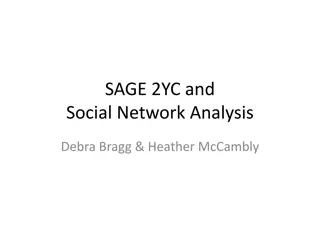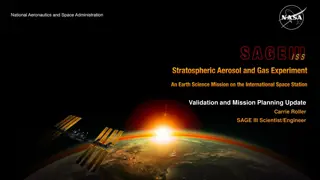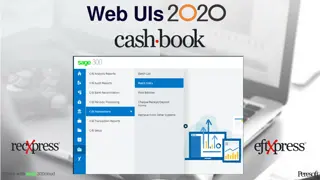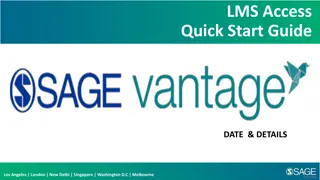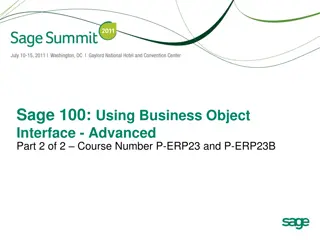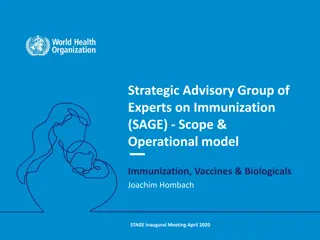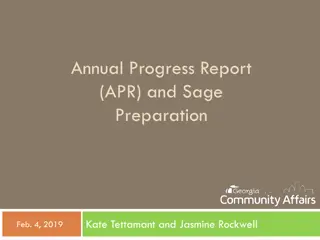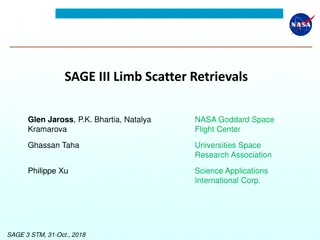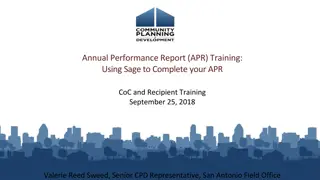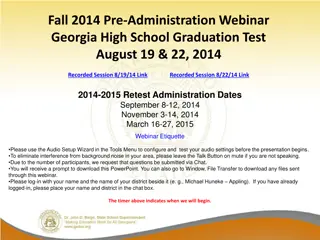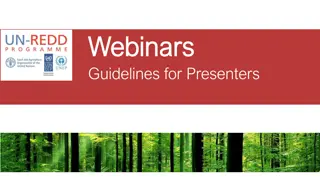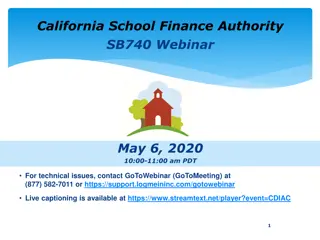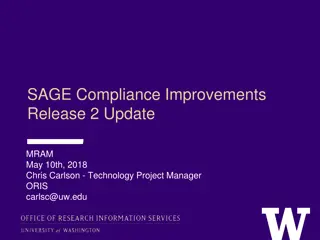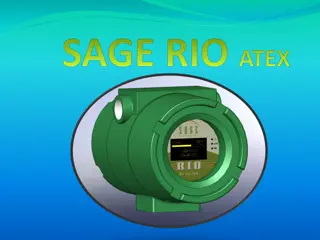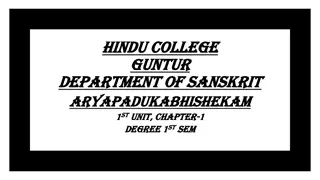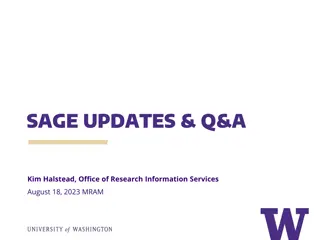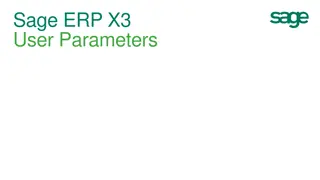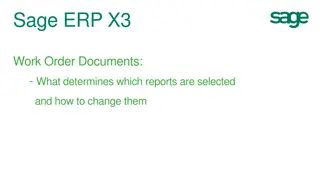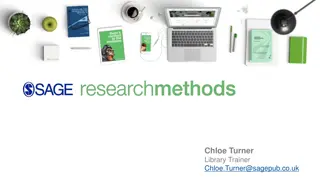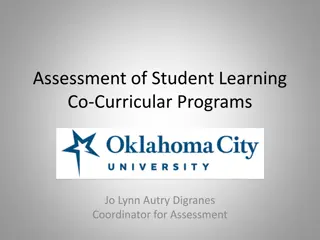Educational Practices and Outcomes Assessment of SAGE 2YC Webinar
Explore the Educational Practices and Outcomes Assessment of SAGE 2YC through the November 2016 webinar featuring experts like Heather Macdonald, Debra Bragg, and Pamela Eddy. The webinar covers the project goals, data collection plan, educational practices inventory, outcomes assessment, and the SAGE 2YC Project Team. Discover the SAGE 2YC goals, project teams' work, and the cycle of innovation aimed at building a network to enhance geoscience education at 2-year colleges.
Download Presentation

Please find below an Image/Link to download the presentation.
The content on the website is provided AS IS for your information and personal use only. It may not be sold, licensed, or shared on other websites without obtaining consent from the author. Download presentation by click this link. If you encounter any issues during the download, it is possible that the publisher has removed the file from their server.
E N D
Presentation Transcript
Educational Practices and Outcomes Assessment of SAGE 2YC Connect to the webinar: http://serc.adobeconnect.com/sage2yc/ Please use phone or skype for audio
Educational Practices and Outcomes Assessment of SAGE 2YC November, 2016 Heather Macdonald, College of William & Mary Debra Bragg and Heather McCambly, Bragg & Associates Pamela Eddy, College of William & Mary Ellen Iverson, SERC
Webinar Goals and Overview Review SAGE 2YC project, goals, and theory of change Introduce plan for collecting data that will allow us to measure project outcomes Educational practices inventory Outcomes assessment, common outcomes measures Q & A about the plan
SAGE 2YC Project Team Evaluation & Research Project Leaders SERC Staff Eric Baer Heather Macdonald Debra Bragg Pamela Eddy John McDaris Carol Ormand Heather McCambly Jan Hodder Norlene Emerson Ellen Iverson
SAGE 2YC Teams and Their Work SAGE 2YC Teams: 24 Faculty Change Agents in 10 regions Administrators Institutional Research Action plans developed at June 2016 workshop considering three project strands Individual Geoscience program/department Regional workshop Project strands Supporting academic success of all students Broadening participation Facilitating students professional pathways
SAGE 2YC Goals Cycle of Innovation Build a national network of 2YC geoscience faculty and administrators led by 2YC faculty leaders, called Change Agents, who catalyze change at multiple levels Implement high-impact, educational practicesthat: Support the academic success of all students Broaden participation Facilitate professional pathways into the geosciences Investigate professional development models that support the cycle of innovation to improve geoscience education Faculty learn from research Faculty share what they are learning with the geoscience education community Faculty make changes in their own practice
Theory of Change Logic Model Cycle of Innovation Outcomes of Educational Practice Changes to 2YC Geoscience Education in: Access Participation Course Success Pathway Progression Change Agents Educational Practices Change Agent Action Plans + + SAGE 2YC Leadership Team Support SAGE 2YC Professional Development Cycle of Innovation
Educational Practices Inventory Research-based practices related to the project goals Academic success of all students Broadening participation in the geosciences Facilitating students professional pathways Two inventories of faculty practices: What individual faculty do What faculty do collectively, in the context of their department or program
Outcomes Assessment Goals Assess implementation of educational practices Apply outcomes assessment to your geoscience program(s) and course(s) Link outcomes assessment to the three strands of SAGE 2YC: Academic success Broadening participation Pathways progression transfer and career
Snapshot of Outcomes Assessment Measures Participation Course Success Outcomes Geoscience Course Enrollment Pathways Progression Outcomes Success in Geoscience Courses Broadening Participation in Geoscience Courses Enrollment in Multiple Geoscience Courses Geoscience Course Success by Student Sub-group Major in Geoscience Program
Approach Use Outcomes Assessment Worksheets, with instructions provided by the SAGE 2YC evaluators, Debra Bragg & Heather McCambly Partner with institutional research (IR) Engage college administration to help secure data, if needed Work collaboratively with Debra Bragg and the leadership team (led by Heather Macdonald) on your assessment plan Start the outcomes assessment in Spring 2017 and continue to the end of the grant
Outcome Measure: Geoscience Course Enrollment Method 1. List geoscience courses offered by your college 2. For each term, indicate whether course is offered and whether the course has received an educational change 3. For each geoscience course offered, count the total number of students enrolled in each course at census date. Question: What is the enrollment in geoscience courses, including courses receiving an educational change , and how does course enrollment change from Spring 2017 to the end of the grant? Measure: Term-by-term enrollment at census date in geoscience courses, including geoscience courses identified as having received an educational change , from Spring 2017 to the end of the grant.
Outcome Measure: Broadening Participation in Geoscience Courses Question: What is the enrollment of underrepresented student groups in geoscience courses, and does geoscience course enrollment by underrepresented student groups change from Winter/Spring 2017 to the end of the grant? Method For each course and by term offered, count students affiliated within sub-groups by gender, race, ethnicity, and other demographic variables (according to IPEDS definitions) at census date. Measure: Term-by-term geoscience course enrollment by student sub- group (e.g., gender, race, ethnicity).
Outcomes Measure: Success in Geoscience Courses Method 1. For each course and by term, count the number of students who completed and passed the course with a grade of C or higher. 2. Compute percentage of students deemed successful (#1) by the total enrollment in same geoscience course. Question: How many students and what percentage of students in geoscience courses succeed, and does course success change from Winter/Spring 2017 to the end of the grant? Measure: Term-by-term geoscience course completion with a grade of C or higher.
Outcome Measure: Geoscience Course Success by Student Sub-Group Question: By sub-group, how many students succeed in geoscience courses, and does the percentage of course enrollee success change from Winter/Spring 2017 to the end of the grant? Method 1. For course and by term, count the number of students within sub-groups who completed and passed the geoscience course with a grade of C or higher. 2. Divide #1 by the total count of students within sub- groups who enrolled in the same geoscience course. Measure: Term-by-term geoscience course completion with a grade of C or higher by student sub-group.
Outcomes Measure: Pathways Progression Question: How many students take more than one geoscience course, how many students major in geoscience, and do these numbers change from Winter/Spring 2017 to the end of the grant? Method 1. By course and by term, count the number of students who enroll at census date who have enrolled in more than one geoscience course. 2. By course and by term, count the number of students who enroll at census data who are declared geoscience majors. Method: Student enrollment in more than one geoscience course. Students with declared major or concentration in geoscience.
Outcomes Measure: Pathways Progression by Student Sub-Group Question: How many students by sub-group who take more than one geoscience course and major in geoscience? How do these numbers change from Winter/Spring 2017 to the end of the grant? Method 1. By course and by term, count the number of students by sub-group who enroll at census date who have enrolled in more than one geoscience course. 2. By course and by term, count the number of students by sub-group who enroll at census data who are declared geoscience majors. Method: Student sub-group enrollment in more than one geoscience course. Student sub-group with declared major in geoscience.
Outcomes Measures Access and Participation Term-by-term enrollment at census date in geoscience courses Term-by-term geoscience course enrollment by student sub-group Course Success Term-by-term geoscience course completion with a grade of C or higher Term-by-term geoscience course completion with a grade of C or higher by student sub-group Pathway Progression Student enrollment in more than one geoscience course Student sub-group enrollment in more than one geoscience course Students with declared major or concentration in geoscience Student sub-group with declared major in geoscience
Timeline for Outcomes Assessment November 2016 this webinar Mid-December 2016 Outcomes Assessment Guide and Worksheets shared with Change Agents January 2017 telephone conference calls to review outcomes assessment plan with Change Agents Educational practices inventories Individual: December 2016 - January 2017 Department: Early winter, 2017 Winter/Spring 2017 Change Agents launch outcomes assessment process June 2017 Change Agent Annual Workshop in Tacoma, WA
Outcomes Assessment Resources Primary Sources: Change Agent Action Plans SAGE 2YC Proposal and Logic Model Other Sources: Gates Foundation/Institute for Higher Education & Policy s scan of 20+ improvement initiatives Alliance for Quality Career Pathways Framework The Voluntary Framework for Accountability Pathways to Results Equity & Outcomes Templates
Questions? Contacts: Outcomes Assessment: Debra Bragg, Bragg.Associates.Inc@gmail.com Inventories: Pamela Eddy, peddy@wm.edu Overall project: Heather Macdonald, rhmacd@wm.edu


